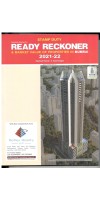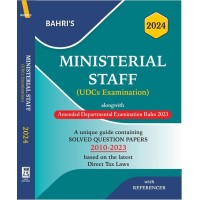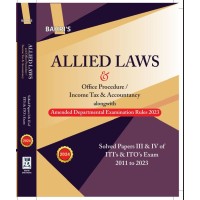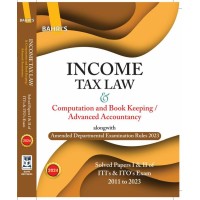National Building Code of India, 2016 by Bureau of Indian Standards SP 7-NBC
National Building Code of India, 2016 by Bureau of Indian Standards SP 7-NBC
- Brand : Bureau Of Indian Standards (BIS)
- Product Code : VBH000345
- Availability : 50
-
Rs13,760.00
- Ex Tax :Rs13,760.00
National Building Code of India, 2016 by Bureau of Indian
Standards SP 7-NBC
The National Building Code
of India (NBC), a comprehensive building Code, is a national instrument
providing guidelines
for regulating the building construction activities across the country. It
serves as a Model Code for adoption by all
agencies involved in building construction works be they Public Works
Departments, other government construction departments,
local bodies or private construction agencies. The Code mainly contains
administrative regulations, development control rules
and general building requirements; fire safety requirements; stipulations
regarding materials, structural design and
construction (including safety); building and plumbing services; approach to
sustainability; and asset and facility management.
The Code was first
published in 1970 at the instance of Planning Commission and then first revised
in 1983. Thereafter three
major amendments were issued to the 1983 version, two in 1987 and the third in
1997. The second revision of the Code
was in 2005, to which two amendments were issued in 2015.
Due to large scale changes
in the building construction activities, such as change in nature of
occupancies with prevalence
of high rises and mixed occupancies, greater dependence and complicated nature
of building services, development of new/innovative
construction materials and technologies, greater need for preservation of
environment and recognition of need for planned management
of existing buildings and built environment, there has been a paradigm shift in
building construction scenario. Considering these,
a Project for comprehensive revision of the Code was taken up under the aegis
of the National Building Code Sectional Committee,
CED 46 of BIS and its 22 expert Panels; involving around 1 000 experts. As a
culmination of the Project, the revised
Code has been brought out in 2016 as National Building Code of India
2016 reflecting
the state-of-the-art and contemporary applicable international practices.
The comprehensive NBC 2016
contains 12 Parts some of which are further divided into Sections totalling 33
chapters (see
Annex 1).
The salient features of the revised NBC (see Annex
2)
include, apart from other changes made, the changes specially in regard
to further enhancing our response to meet the challenges posed by natural
calamities. The major changes incorporated in this
third revision of the Code are as follows:
a) Provisions for
association of need based professionals and agencies have been updated to
ensure proper discharge of responsibilities for accomplishment of building
project.
b) With a view to
ensuring ease of doing business in built environment
sector, a
detailed provision for streamlining the approval process in respect of
different agencies has been incorporated in the form of an integrated approval
process through single window approach for enabling expeditious approval
process, avoiding separate clearances from various authorities.
c) Further, with a view to
meeting the above objective, the provision on
computerization of approval process has been detailed,
enabling online submission of plans, drawings and other details, and sanction
thereof, aiding in speedier approval process.
d) The mechanism of
ensuring certification of structural safety of buildings by the
competent professional and peer review of design of buildings, have been
further strengthened.
e) Requirements for accessibility
in buildings and built environment for persons with disabilities and the
elderly have
been thoroughly revised and updated.
f) Provisions on fire
and life safety have
been thoroughly revised to meet the challenges of modern complex building types
including the high rises.
g) Latest structural
loading and design and construction codes including those relating to wind
load,
earthquake resistant design of buildings, steel
design and foundations have been incorporated with a view to ensuring
structural safety of buildings including against a disaster.
h) Provisions relating to
all building and plumbing services have been updated
keeping also in view the latest international practices as related to the
country.
j) Provisions have been
updated to ensure utilization of number of
new/alternative building materials and
technologies to
provide for innovation in the field of building construction.
k) Construction
management guidelines
have been incorporated to aid in timely completion of building projects with
desired quality in a safe manner within the budgeted cost.
m) Guidance has been
provided for making buildings and built environment energy efficient and
environmentally compatible, through the newly introduced and updated chapter on
sustainability, namely Part 11 ‘Approach to Sustainability’
n) New
chapters have
been added on structural use of glass; escalators and moving walks; information
and communication enabled installations; solid waste management; and asset and
facility management.
The Code has been published
in two volumes containing all the Parts and Sections.
The publication is
available from Sales Counter at BIS Headquarters as well as various Regional
and Branch Offices of BIS.
Annex
1
CONTENTS
OF NBC 2016
VOLUME 1
PART 0 INTEGRATED APPROACH
– A PRE-REQUISITE FOR APPLYING THE PROVISIONS OF THE CODE
PART 1 DEFINITIONS
PART 2 ADMINISTRATION
PART 3 DEVELOPMENT CONTROL
RULES AND GENERAL BUILDING REQUIREMENTS
PART 4 FIRE AND LIFE SAFETY
PART 5 BUILDING MATERIALS
PART 6 STRUCTURAL DESIGN
Section 1 Loads, Forces and
Effects
Section 2 Soils and
Foundations
Section 3 Timber and Bamboo
3A Timber
3B Bamboo
Section 4 Masonry
Section 5 Concrete
5A Plain and Reinforced
Concrete
5B Prestressed Concrete
Section 6 Steel
Section 7 Prefabrication
and Systems Building and Mixed/Composite Construction
7A Prefabricated Concrete
7B Systems Building and
Mixed/Composite Construction
Section 8 Glass and Glazin
VOLUME 2
PART 7 CONSTRUCTION
MANAGEMENT, PRACTICES AND SAFETY
PART 8 BUILDING SERVICES
Section 1 Lighting and
Natural Ventilation
Section 2 Electrical and
Allied Installations
ection 3 Air Conditioning,
Heating and Mechanical Ventilation
Section 4 Acoustics, Sound
Insulation and Noise Control
Section 5 Installation of
Lifts and Escalators and Moving Walks
5A Lifts
5B Escalators and Moving
Walks
Section 6 Information and
Communication Enabled Installations
PART 9 PLUMBING SERVICES
(INCLUDING SOLID WASTE MANAGEMENT)
Section 1 Water Supply
Section 2 Drainage and
Sanitation
Section 3 Solid Waste
Management
Section 4 Gas Supply
PART 10 LANDSCAPE
DEVELOPMENT, SIGNS AND OUTDOOR DISPLAY STRUCTURES
Section 1 Landscape
Planning, Design and Development
Section 2 Signs and Outdoor
Display Structures
PART 11 APPROACH TO
SUSTAINABILITY
PART 12 ASSET AND FACILITY
MANAGEMENT
Annex
2
Salient
Features of National Building Code 2016 (NBC 2016)
1) Detailed provision
for streamlining the approval process in respect of
different agencies in the form of an integrated approval process through single
window approach thereby avoiding separate clearances from various authorities,
with a view to ensuring ease of doing business in built environment
sector.
2) Progressive
computerization of approval process, for enabling online submission of plans,
drawings and other details, and sanction thereof.
3) Updated mechanism of
ensuring certification of structural safety of buildings by the
competent professional and peer review of design of buildings.
4) Defining the roles and
responsibilities of all professionals and contractors involved in a building
construction project.
5) Comprehensive planning
norms for minimum amenities to be provided in a city/town.
6) Detailed provisions
relating to requirements for accessibility in buildings and
built environment for
persons with disabilities and the elderly.
7) Planning and development
norms, such as, Transferable Development Rights (TDR) and Accommodation
Reservation (AR).
8) Provisions for
underground or multi-storeyed parking as also mechanized
parking of vehicles.
9) Norms for solar
energy utilization.
10) Requirements for
buildings on podium for ensuring fire and life safety in such buildings.
11) Fire
and life safety in modern complex buildings including the high rises, glazed
buildings, atria, commercial kitchen and car parking facilities.
12) Updated structural
design provisions for
wind and seismic loads, imposed load due to helipad, and blast loads, for safedesign
and construction of buildings with due focus on ductile detailing.
13) Latest research and
development inputs and provisions on concrete, steel and masonry buildings with
a view to ensuring disaster resilient buildings.
14) Assessment of
liquefaction potential of a site and ground improvement techniques for maximum
utilization of land resources including at seismically vulnerable sites.
15) Updated provisions on
engineered use of bamboo in housing and other building
construction.
16) Promotion of use
of agricultural and industrial wastes including construction
and demolition wastes in
building construction without compromising the quality and safety.
17) Inclusion of provisions
on self compacting concrete, high performance concrete and steel fibre
reinforced concrete.
18) Updated provisions
on prefabricated construction technique for speedier
construction.
19) New chapter on structural




